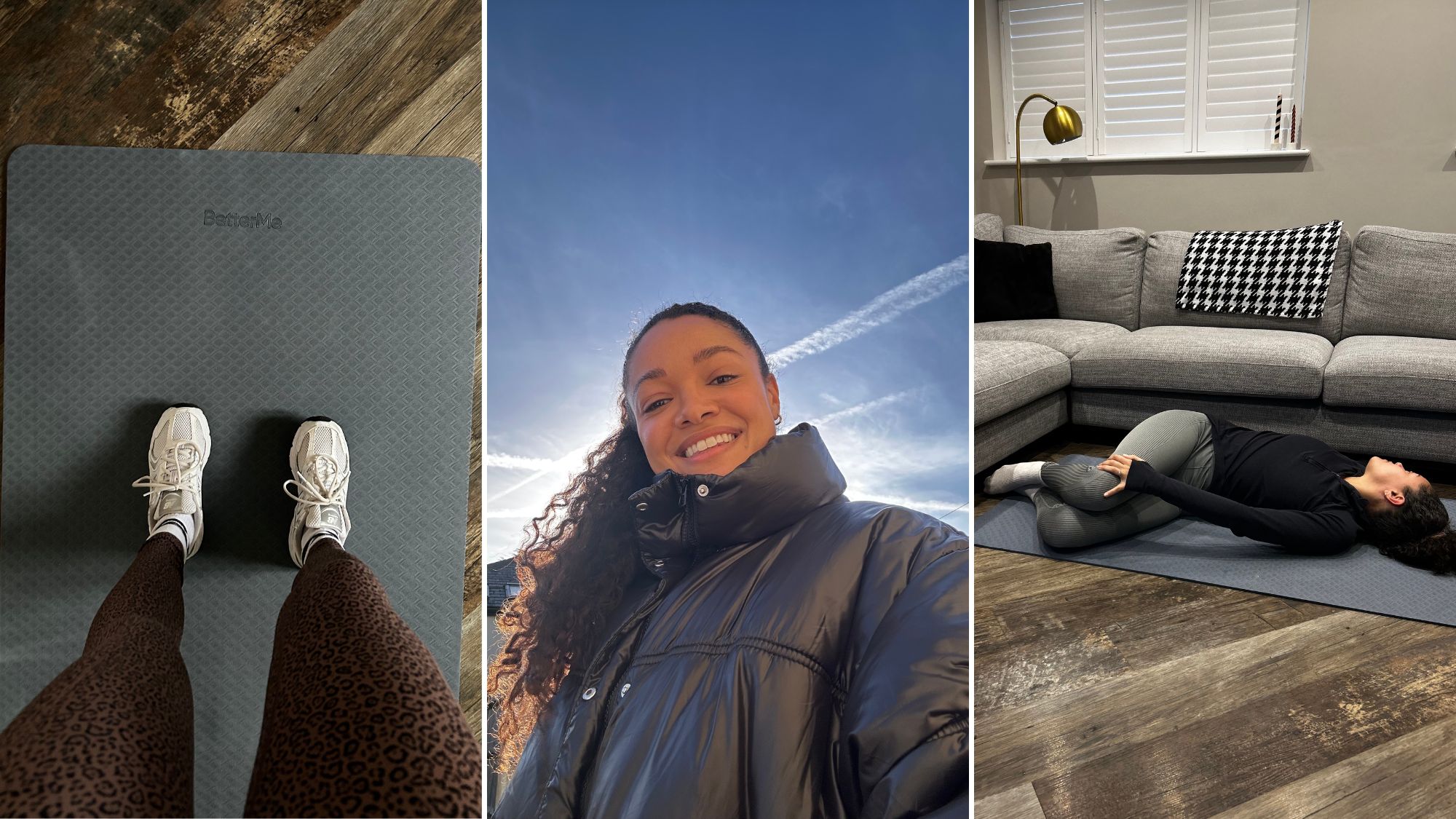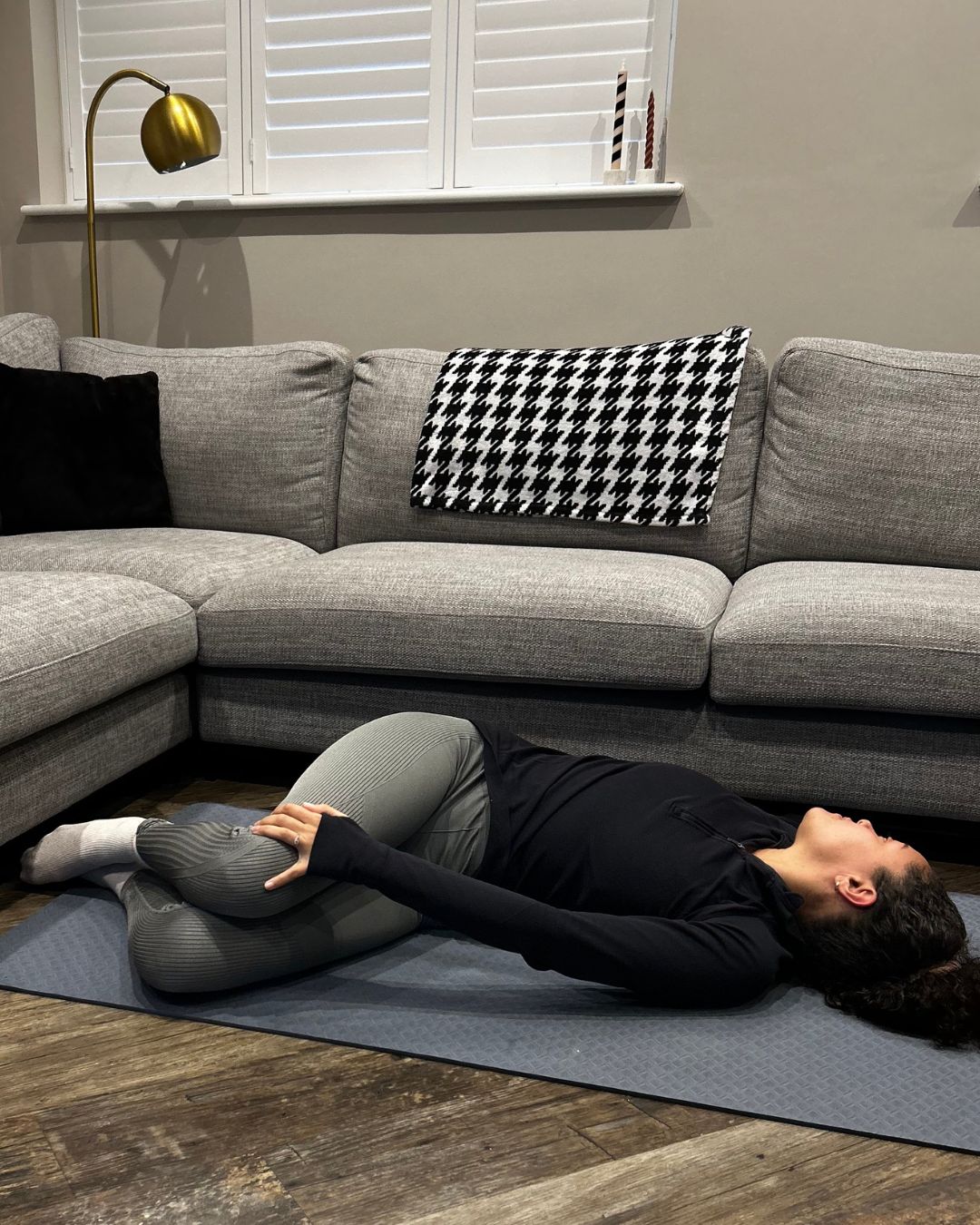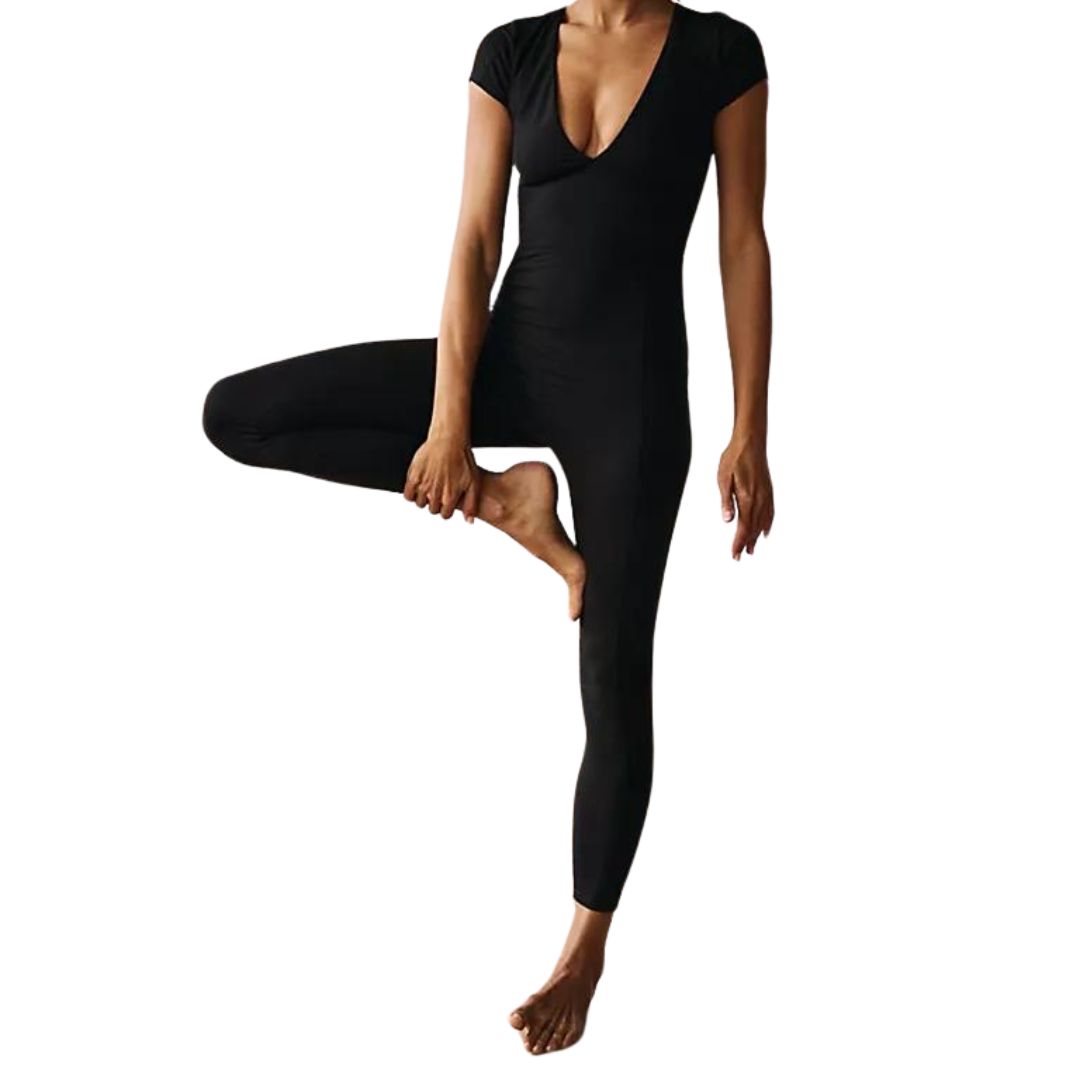I completed a 7-day posture challenge and honestly? I'm shocked at what it's taught me about my body
Plus some tips on how to permanently improve your posture.


Hunched up shoulders, tight hips and an achy back sound all too familiar? I’m with you. But that's why, since WFH became my norm, I’ve been scouring the internet to uncover how to permanently improve posture, reduce back pain (hello lower back pain exercises) and give my flexibility a much-needed upgrade. Enter: Eleanor Burt's AKA Posture Ellie's seven-day posture challenge.
Before I get stuck in, it’s worth highlighting a few things. Firstly, poor posture doesn’t just affect our musculoskeletal system. As researchers in this 2022 study found, holding a stance that deviates from a neutral trunk position for just three consecutive minutes can affect the cardiovascular and autonomic nervous systems resulting in "decreased stroke volume (the amount of oxygenated blood pumped from the heart in one beat), increased heart rate and relative activation of sympathetic tone" (so essentially, your nervous system is under more stress). Pretty eye-opening stuff.
Secondly: there is no "perfect" posture, as Florence Penny, consultant musculoskeletal physiotherapist and founder of Flow Physio London enlightens me. “Posture is dynamic and evolves with movement; there’s no static position that fits everyone perfectly," she says. "Therefore, prioritizing activities that enhance flexibility, core strength and mobility is crucial for overall well-being. By understanding that posture is more about functional movement and strength than attaining a perfect stance, individuals can take proactive steps to mitigate the negative consequences of poor posture.”
Which is where my posture challenge steps in. Tasked with completing seven different posture exercises each day, I discovered more than I first thought. To find out what happened, stick right here. Plus, while I have your attention, you may also be interested in adding a handful of mobility exercises to your stretching roster to help ease tightness and tension.
I tried a 7-day posture challenge - here's how I got on
But first, what is a posture challenge?
As the name suggests, a posture challenge is a series of daily exercises, holds or positions to help you gain awareness about your body (and perhaps its limitations).
Burt’s seven-day challenge drops a new ten to fifteen-minute video in your inbox every day, covering just one posture exercise. “These videos help to show you how much is actually going in seemingly innocuous exercises and how much a bit time in one simple looking position can make you feel wildly different, quite quickly,” Posture coach Burt says.
A post shared by Eleanor Burt - Posture Coach (@postureellie)
A photo posted by on
Why is it important to have good posture?
Good posture is important to your overall health. Along with helping you avoid pain, discomfort, muscle tension and other ailments, a strong posture will help you lead a better quality of life, giving you the freedom to move, stand and sit efficiently.
Celebrity news, beauty, fashion advice, and fascinating features, delivered straight to your inbox!
“Your posture is your home,” Burt says. “When your posture is crumbling down, your home is crumbling down. To the symptom-driven Western world, this might seem mad. But if you look at the bigger picture, if a house collapses (imagining that the house is our bones and joints), everything in it also gets crushed. We can't separate the systems in our body, they all need to work together in harmony.”
What are the complications of poor posture?
All that hunching over your computer, slouching on the sofa or hanging of your head downwards while doom scrolling can have a number of repercussions on our body and overall health.
For example, poor posture can cause:
- Musculoskeletal issues, like back pain or neck strain.
- Reduced respiration function, so could involve having shortness in breath.
- Compromised circulation.
- Headaches which the NHS says are due to tension in your upper back, neck and shoulders.
- Digestive issues.
The above can all cause a reduced quality of life. As Burt explains: “Bad posture equals misery. Misery through pain and constant injury, misery through fear of pain, misery through foggy-headedness and fatigue, misery through restricted breathing... my list could go on.”
So, how can you permanently improve posture?
As is the case with many health woes, there is no magic pill or quick fix for improving your posture. However, there are a wealth of expert-backed health and lifestyle changes that can help you achieve lasting posture improvements. Phew.
So along with doing your best to keep your spine in a neutral position, tips include:
- Strength training. Whether it’s bodyweight exercises or you’re interested in lifting weights, strength training can help to provide the building blocks of a better posture by activating the muscles in your body, strengthening your frame and turning back the hands of time on muscle deterioration. If you’re wondering where to begin, Penny suggests starting with movements designed to test the range of movement at the spine. This could include the likes of a bird dog, bridge or dead bug. “Building strength in the upper back muscles also can help,” the expert says, so do bookmark our guide to the best back workouts.
- Practising Pilates. Joined the Pilates hype yet? Well, if posture is your mind, now could be the time to do so. “Pilates stands out as an excellent workout regimen for enhancing strength, posture, balance and flexibility,” Penny says and there’s research, like this 2023 systematic review, to prove it. In the review, researchers concluded that this low-impact mind-body exercise specifically has a positive impact on ‘improving spinal deformity and posture’.
- Using a proper ergonomic desk set-up. Work from home or in an office? “If you sit in a chair all day, do so properly,” Penny implores. “Make sure you use the full support of your desk chair by sitting all the way to the back, instead of perching on the edge and ensure the desk is set at the appropriate height also.”
- Paying closer attention to your standing posture. “Observe if you tend to lean against objects or favour one leg over the other,” Penny says. “Concentrate on aligning your hips directly over your feet and your shoulders directly over your hips.” This will help you keep your spine in a neutral position.
- Stretching. Remember: movement is medicine and making stretching the main event, rather than just an accessory to exercise, could make all the difference to your posture by increasing muscular flexibility. “Sitting in the incorrect position for long periods can cause tension in the hip flexors,” Penny warns. “Take time to stretch the hip flexors at the end of the day.” To combat hunching and encourage the chest to open, you could also try lying on your back on a rolled-up yoga mat, Penny adds.
- Giving some serious consideration to your footwear. “Most people are wearing heeled shoes, even if they think they aren't,” Burt tells us. “The worst is 'normal trainers',” she says. “Most trainers are heels that not only deform your feet (into points), pitch you forwards (so your body is always having to pull itself backwards to balance) but also create huge instability (due to all the crazy amount of 'fluff' in the soles). This huge instability causes pain all over the body, not immediately, but eventually, and I wish people could see it.” The solution? Well, you could go barefoot or try minimalist footwear which provides less cushioning and ‘fluff’ and helps to keep the body in a neutral alignment.
How I got on trying my own posture challenge
Days one to three
The first posture exercise lands in my inbox and it’s a good 'un. Burt appears on screen and guides me into a static back position by encouraging me to lie down on the floor and place my legs up on a surface at a 90-degree angle. She tells me this will coax my back into a state of "passive back relaxation" - and that it does. My spine feels lengthened, my chest and shoulders feel open and I find myself thinking, "Why haven’t done this before?". Before I get too comfy, I’m asked to start foot circling, which might not sound like much but as the minutes pass, it’s a pretty humbling experience. Not only do I notice that my shoulders gradually start to cinch upwards towards my ears as I concentrate on each foot, but the intensifying burning sensation in my feet lets me know that they’re probably a little bit stiffer than I thought. I make a mental note to revisit this exercise throughout the week until this movement feels fluid.
Day two is much like the first: a pretty thorough learning experience in what my body can (and can’t) do. I learn that as I execute a static wall position while pulling my feet back towards me and squeezing my quads, I can get my pelvis flat to the floor and I can do the same with my lower back and ribcage. But I struggle to hold this position for four minutes straight, as guided. Let’s just say the fronts of my legs were well and truly alive!
By day three I’ve found a new favourite tension-releasing exercise. Introducing: the "Towel Settle with Strap." Heard of it? Essentially, it involves placing a towel under your back and neck and a stretching strap around your thighs in a bid to get your abductors all fired up. “When we are sitting down for many hours of the day with our knees crossed or folded, these guys aren’t working,” Burt explains as she executes the deliciously satisfying move on screen. And, among a long list of other things, Burt highlights that these hip abductor muscles are "really important" when it comes to walking well, running well and stabilising the pelvis. Noted.

Rebecca during her seven day posture challenge
Days four to seven
Day four was a "towel settle with block" and involved placing a yoga brick between your thighs and squeezing to hit your adductors. As I quickly discovered, this is a muscle group I don’t often give much air time. While the following day's challenge was an upper spinal twist, which if you have a tight achy back like me, might just become your go-to for releasing some pent-up tension in your thoracic spine, day six called for a modified floor block position followed by a wall pigeon-toed pose on the finale.
Of course, it’s common knowledge that we should all be moving more and sitting less. But sinking into these simple exercises for more minutes than usual has hammered home in real-time just why that’s the case. “When we don't move properly (or enough), our bones start to lose their alignment,” Burt told me. “Muscles hold the bones in place. When the function of our muscles degrade or become imbalanced, it pulls the bones out of place,” she adds. “This then causes pain in all sorts of ways.”
Seven days wasn’t enough to correct my posture forever — and Burt flags this from the start. But it did highlight a few things. At the end of the challenge, I feel like I’ve given my body a bit of an MOT. I’ve discovered the areas of my body that are more fluid and which parts probably need a little bit of TLC (I'm looking at you shoulders, hips and feet!). I’ve also left the week with a bank of exercises to master, a new found love for my abductors and adductors and a baseline of where my body is at (and where I want it to go). Not bad at all.
Shop MC UK's go-to workout kit:
Is it ever late to correct poor posture?
Short answer: no, it’s never too late to give your posture a boost. “While it’s true that correcting posture becomes more challenging as you age or if certain musculoskeletal conditions are present, it’s rarely impossible,” confirms Florence Penny, consultant musculoskeletal physiotherapist and founder of Flow Physio London.
“As we age, age-related changes, such as reduced muscle mass and decreased bone density can make us more prone to altered posture,” Penny tells us. And unfortunately, this effect is more pronounced in women due to declining estrogen levels and the menopause. But other factors such as muscle weakness, tightness, imbalances and habitual patterns (like a questionable work from home posture) can contribute to a weakened postural position.
The good news? “Addressing these issues through targeted exercises, stretching routines, ergonomic adjustments and mindfulness can gradually correct posture over time,” the expert adds. However, Penny does flag that it’s essential to manage expectations as everyone’s body (and therefore posture) is unique. “Complete transformation may not always be achievable,” she adds.

Rebecca, or Becks, is a freelance journalist with more than ten years of experience in the industry. She specialises in all things health and lifestyle and has written for a number of brands including Women's Health, Stylist, the Evening Standard, Good Housekeeping, The Telegraph, Live Science, Tom's Guide and Fit&Well. Becks also writes copy for a number of brands and small businesses.
When she's not weight training, tracking down the best gym leggings, reading a book or at her desk typing away, you'll find her in the kitchen perfecting a new recipe or bake.


